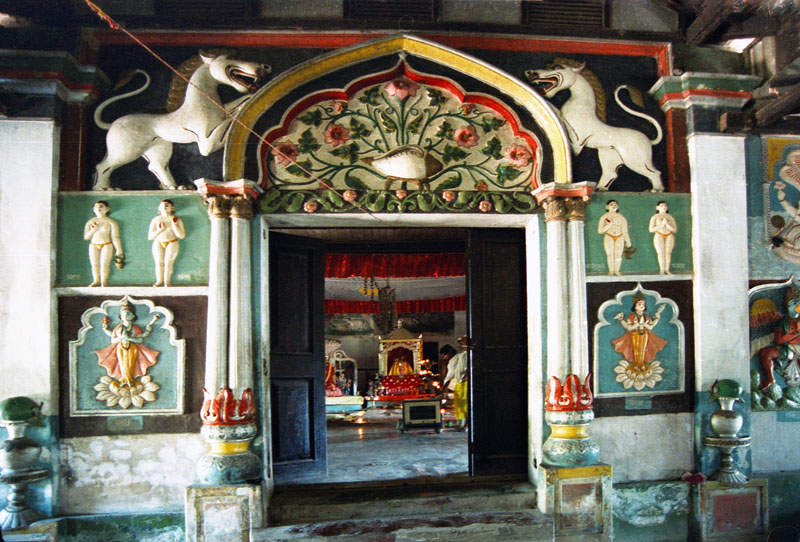|
List Of Satras
Satras are Ekasarana monasteries established by Mahapurush Shrimanta Sankardev (1449-1568 AD) and his disciples Shri Shri Madhabdev, Damodardev and also their disciples and followers in Assam and adjoining areas. The chief of a Satra is called a ''Satradhikar''. Generally Satras are treasure troves of cultural artifacts. List of Satras References {{Reflist External links The Satrasat atributetosankaradeva.org. SATRA CULTURE : A Brief Introductionat enajori.com. Ekasarana Dharma Satras Satras Satras are institutional centers associated with the Ekasarana tradition of Vaishnavism, largely found in the Indian state of Assam and neighboring regions. Numbering in the hundreds, these centers are generally independent of each other and ... *List ... [...More Info...] [...Related Items...] OR: [Wikipedia] [Google] [Baidu] |
Sattra
Satras are institutional centers associated with the Ekasarana tradition of Vaishnavism, largely found in the Indian state of Assam and neighboring regions. Numbering in the hundreds, these centers are generally independent of each other and under the control of individual ''adhikaras'' (or ''satradhikars''), though they can be grouped into four different ''Sanghatis'' (orders). These centers, in the minimum, maintain a prayer house (''Namghar'', or '' Kirtan-ghar''), initiate lay people into the Ekasarana tradition and include them as disciples of the Satra from whom taxes and other religious duties are extracted. The Neo-Vaishnavite satra culture started in the 16th century. They grew rapidly in the 17th century and patronage extended to them by first the Koch kingdom and later the Ahom kingdom was crucial in the spread the Ekasarana religion. Many of the larger Satras house hundreds of celibate and non-celibate ''bhakats'' (monks), hold vast lands and are repositories of r ... [...More Info...] [...Related Items...] OR: [Wikipedia] [Google] [Baidu] |
Dakshinpat Satra
Dakshinpat Xatra is a well-known Xatra (socio-religious institution) on Majuli island in the Brahmaputra River, in the Indian state of Assam established by Vamshigopal disciple Satradhikar Sri Vanamalidev in 1584. He was honoured and treated with much respect by the reigning Ahom kingdom monarch Jayadhwaj Singha who made liberal gifts to the Xatra. An ornate gateway engraved with religious motifs, animals and flowers forms the entrance while inside similar sculptures and paintings with divine overtones adorn the walls of the Namghar and heighten the aesthetic appeal of the sacred precincts where the idol of Mahaprabhu Jadavarai is worshipped. Dakshinpat Xatra is a treasure house of dances contributed by Shri Shri Sankardeva such as the Borgeet, Matiakhara, Jumora, Chali, Noyua, Nande Vringee, Sutradhar, Ozapali, Apsara, Satria Krishna and Dasavater among others while it is also a storehouse of antiques of cultural importance and an advanced centre for the performing arts. ... [...More Info...] [...Related Items...] OR: [Wikipedia] [Google] [Baidu] |
Monasteries In India
A monastery is a building or complex of buildings comprising the domestic quarters and workplaces of monastics, monks or nuns, whether living in communities or alone (hermits). A monastery generally includes a place reserved for prayer which may be a chapel, church, or temple, and may also serve as an oratory, or in the case of communities anything from a single building housing only one senior and two or three junior monks or nuns, to vast complexes and estates housing tens or hundreds. A monastery complex typically comprises a number of buildings which include a church, dormitory, cloister, refectory, library, balneary and infirmary, and outlying granges. Depending on the location, the monastic order and the occupation of its inhabitants, the complex may also include a wide range of buildings that facilitate self-sufficiency and service to the community. These may include a hospice, a school, and a range of agricultural and manufacturing buildings such as a barn, a forge ... [...More Info...] [...Related Items...] OR: [Wikipedia] [Google] [Baidu] |
Ekasarana Dharma
Ekasarana Dharma (literally: ''Shelter-in-One religion'') is a neo-Vaishnavite monolithic religion propagated by Srimanta Sankardeva in the 15th-16th century in the Indian state of Assam. It reduced focus on vedic ritualism and focuses on devotion (''bhakti'') to Krishna in the form of congregational listening (''sravan'') and singing his name and deeds (''kirtan''). The simple and accessible religion attracted already Hindu as well as non-Hindu populations into its egalitarian fold. The neophytes continue to be inducted into the faith via an initiation ceremony called ''xoron-lowa'' (literally: take-shelter), usually conducted by ''Sattradhikars'', heads of monastic institutions called Sattras, who generally draw apostolic lineage from Sankardev. Some Sattradhikars, especially those from the Brahma-sanghati, reject apostolic lineage from Sankardev due to an early schism with the order. Some modern reformation institutions conduct ''xoron-lowa'' outside the ''sattra'' inst ... [...More Info...] [...Related Items...] OR: [Wikipedia] [Google] [Baidu] |
Bor Jodumoni
Bor may refer to: Places Populated places * Bor (Tachov District), a town in Plzeň Region, Czech Republic * Bor, Petnjica, Montenegro * Bor, Russia, the name of many inhabited localities in Russia * Bor District, a district in Serbia ** Bor, Serbia, a town in Bor District * Bor, South Sudan, the capital of Jonglei State, South Sudan * Bor County, in Jonglei State, South Sudan * Bor, Sweden, a village in Jönköping County, Sweden * Bor, Niğde, a district center of Niğde Province, Turkey * Bór (other), various settlements in Poland Other places * Bor (Martian crater) * Bor (PKP station), a former railway station in Hel, Poland * Bor Airport (South Sudan) People *Bor (name), notable people with this surname or given name Fiction and mythology *Borr, sometimes anglicized Bor, a god in Norse mythology, father of the god Odin *Bor (comics), an Asgardian in the Marvel Universe Other * Bill of rights * Bor fruit, more commonly known as Ber * Bor language (disambigua ... [...More Info...] [...Related Items...] OR: [Wikipedia] [Google] [Baidu] |
Soru Jodumoni
Soru may refer to: * Renato Soru, an Italian internet entrepreneur * Sõru, village in Hiiumaa Parish, Hiiu County, Estonia * Soru, Azerbaijan, municipality in Lerik District Lerik District ( az, Lerik rayonu, tly, Lik rəyon, script=Latn) is one of the 66 districts of Azerbaijan. It is located in the south-east of the country and belongs to the Lankaran-Astara Economic Region. The district borders the districts of ..., Azerbaijan * Soru, Nepal, rural municipality in Karnali province, Nepal See also * Ab Soru, a village in Iran * Saru Castles * Sors, Azerbaijan {{Disambiguation, geo, surname ... [...More Info...] [...Related Items...] OR: [Wikipedia] [Google] [Baidu] |
Goalpara
Goalpara, Pron: ) is the district headquarters of Goalpara district, Assam, India. It is situated to the west of Guwahati. Etymology The name Goalpara is said to have originated from the word "Gwaltippika" meaning Guwali village, or The village of the milk men (Yadav). In local dialect, "para" means village. Geography Goalpara is located on the bank of the river Brahmaputra River, Brahmaputra. It has an average elevation of 35 metres (114 feet). Goalpara is endowed with scenic beauty. Hulukanda Hill, located at the heart of Goalpara on the bank of the Brahmaputra river, is one of the natural scenic views in the town, with various kinds of waterfowl and monkeys. There are some other bodies of water such as Hashila beel, Kumri beel, and Urpad Beel. The Urpad Beel becomes the centre of migratory birds during Oct-March. The evergreen forests on low hills create an undulating landscape. Goalpara district consists of 8 blocks: *Balijana *Jaleswar *Kharmuza *Krishnai *Ku ... [...More Info...] [...Related Items...] OR: [Wikipedia] [Google] [Baidu] |
Sri Sri Lakhmi Narayandev
Shri (; , ) is a Sanskrit term denoting resplendence, wealth and prosperity, primarily used as an honorific. The word is widely used in South and Southeast Asian languages such as Marathi, Malay (including Indonesian and Malaysian), Javanese, Balinese, Sinhala, Thai, Tamil, Telugu, Hindi, Nepali, Malayalam, Kannada, Sanskrit, Pali, Khmer, and also among Philippine languages. It is usually transliterated as ''Sri'', ''Sree'', ''Shri'', Shiri, Shree, ''Si'', or ''Seri'' based on the local convention for transliteration. The term is used in Indian subcontinent and Southeast Asia as a polite form of address equivalent to the English "Mr." in written and spoken language, but also as a title of veneration for deities or as honorific title for local rulers. Shri is also another name for Lakshmi, the Hindu goddess of wealth, while a ''yantra'' or a mystical diagram popularly used to worship her is called Shri Yantra. Etymology Monier-Williams Dictionary gives the meaning of the r ... [...More Info...] [...Related Items...] OR: [Wikipedia] [Google] [Baidu] |




